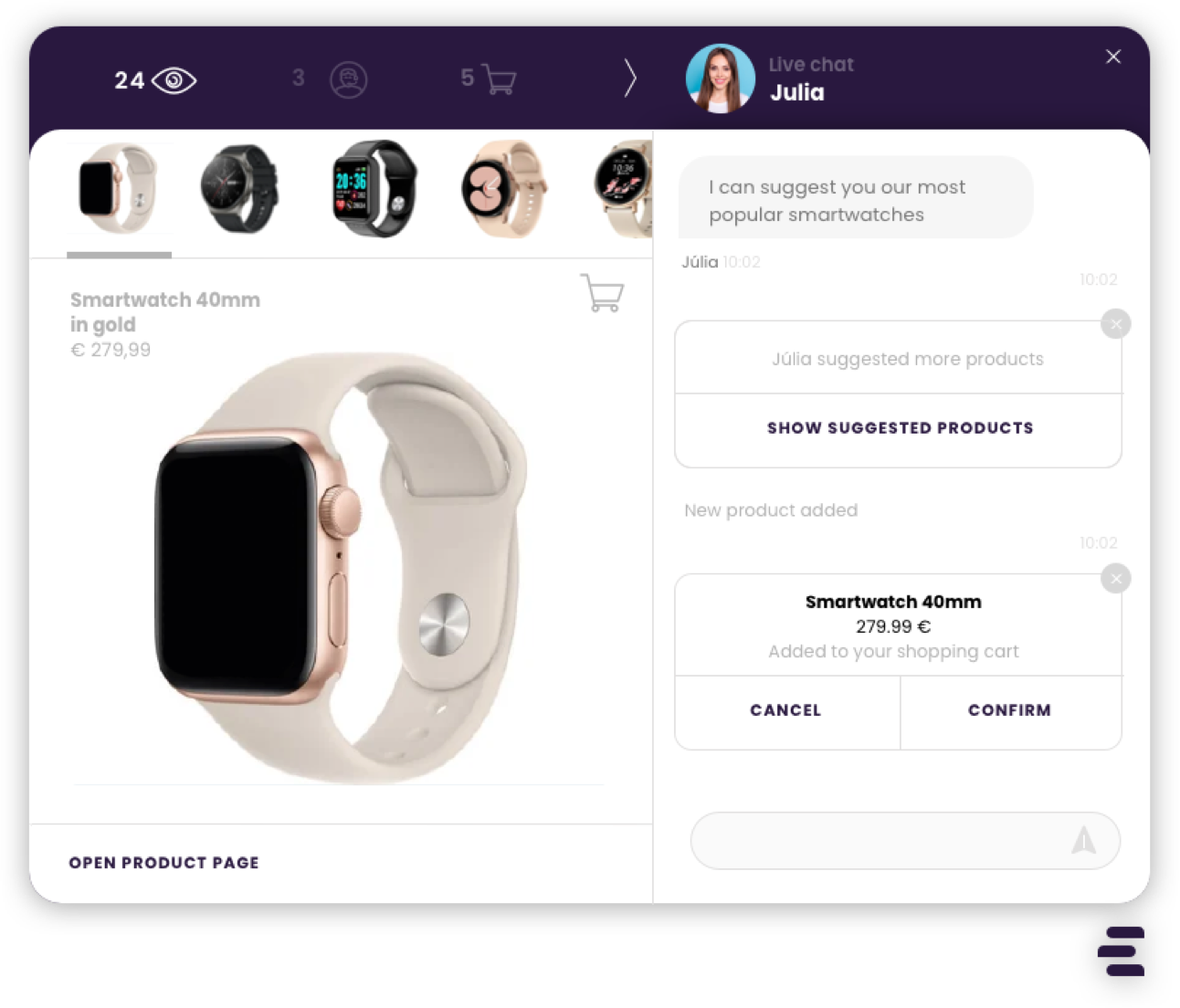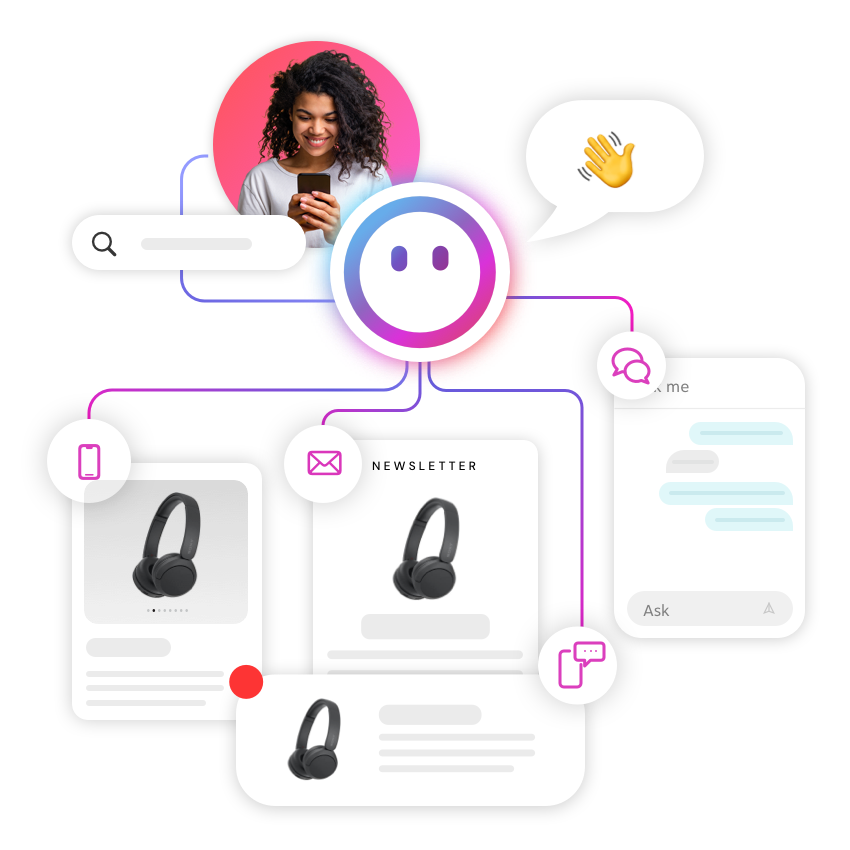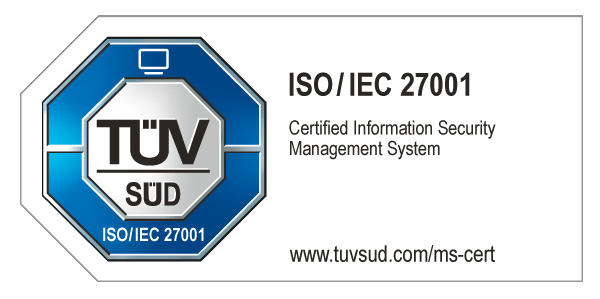Guided selling is the latest game-changer in commerce. In a world filled with choices, consumer empowerment is at its peak, but also decision fatigue. This shift has led businesses to adapt their strategies to the customer's journey, with guided selling emerging as the solution. Leveraging artificial intelligence (AI) and machine learning tools, it prioritizes customer needs and employs a more effective sales approach, all while keeping a perfect balance between automation and a human touch.
What is guided selling?
Guided selling is a customer-centric, data-driven approach that leverages customer insights to assist them make informed purchasing decisions. This process often uses AI-powered software and the analysis of current and past sales data, as well as customer information.
By tapping into the power of these data points, guided selling empowers consumers to find the products and solutions that suit their needs and preferences, and sales representatives to offer personalized product recommendations.
This tailored guidance not only enhances the overall customer experience by providing a human touch to the process but also boosts successful conversions, creating a win-win relationship between customer satisfaction and sales results.
Guided selling in the digital era
While digital channels are gaining increasing importance in sales, they still play a significant role in product discovery and information gathering. Numerous customers prefer to conduct their research online but finalize their purchases in retail stores. Some individuals may feel uneasy with online transactions, while others prefer the hands-on experience of seeing and touching products before making a decision. In short, certain products and services are more challenging to sell online.
To address this, companies must improve their response times and excel in their digital presence by guiding customers through the entire sales funnel, ultimately leading to more and better conversions. This trend is already in progress. As outlined by Gartner, 75% of B2B sales organizations will incorporate AI guided selling solutions in traditional sales by 2025.
Also, according to McKinsey & Company, 71% of consumers expect companies to provide personalized interactions, and 76% become frustrated when this expectation is not met. So, it's safe to say that the key lies in leveraging the potential of personalization to increase conversion rates – in simpler terms, to close sales online.
How does guided selling work?
By making use of AI-driven data analytics tools, guided selling creates solutions that assist consumers in every stage of the buying journey. The main goal is not just to drive sales at any cost but, more importantly, to present buyers with options that truly fit their needs. This involves providing data-driven explanations for each option, setting guided selling apart from typical sales methods.
In a traditional e-commerce approach, customers discover a website through marketing efforts (e.g. customized ads, social media) and navigate potential purchase options independently, often having to sort through confusing product specifications and requirements. In physical stores, sales associates collect this information by asking questions like 'What are you looking for?' and 'How much are you willing to spend?’. In guided selling, however, customers receive a specific selection of product recommendations based on collected data.
It's important to highlight that guided selling is used in both business-to-business (B2B) and business-to-consumer (B2C) situations. While B2B scenarios often involve direct communication between account managers and business stakeholders, B2C solutions rely on data-driven digital methods to guide customers to the right products.
Guided selling in B2B
In B2B environments, guided selling tools assist sales representatives in developing a thorough understanding of the product or service they are selling and following a streamlined sales process. They establish a framework that the sales rep can use to guide the solution buyer to the best option at every stage, ensuring alignment of needs and expectations. This is particularly useful when dealing with complex products or pricing, assisting sales reps ask the right questions at every stage of the sales funnel. It can take the form of a sales playbook, for instance, that helps enhancing conversions and customer satisfaction rates while reducing sales cycles.
Guided selling in B2C
In B2C, guided selling often adopts a questioning approach, focusing on understanding customer needs and preferences. In physical stores, this involves knowledgeable salespeople who can ask the right questions and attentively listen to customers. In online contexts, such as e-commerce, it typically combines an AI-driven approach to empower customers in making the best decisions and reducing decision fatigue. This can include smart chatbots, product configurators, quizzes, or chats operated by sales agents that offer real-time product recommendations.

BySide Smart Windows, a contact window that blends e-commerce intelligence and human support
These guided selling experiences boost customer confidence and overall satisfaction, increasing the likelihood of repeated purchases and reducing the chances of refunds or returns— all achieved through enhanced personalization.
Guided selling as a sales strategy
Whether online or in person, the customer should always be at the center of any successful sales strategy. To create a guided selling approach in the digital space, it’s important to follow these steps:
- Walk in your customers’ shoes
- Create trust and empathy by asking the right questions
- Make best-fit suggestions driven by data and AI
- Don’t forget the human touch
Step 1: Walk in your customers’ shoes
To provide the best possible customer experience (CX) and gain their trust and loyalty, it’s important to understand customers’ expectations. This means conducting research and gathering data to create detailed customer profiles, which involves taking the time to listen to their concerns and asking the right questions.
Step 2: A Create trust and empathy by asking the right questions
Successful interactions require asking questions that enable customers to respond based on their needs and preferences, rather than the specifics of a product or service. Unfortunately, many strategies fail to achieve this and instead view interactions through the lens of their products, without truly considering consumer requirements.
Step 3: Make best-fit suggestions driven by data and AI
The next step is to make suggestions based on the gathered data. This involves providing tailored recommendations and advice using approaches such as Next Best Offer (NBO) and Next Best Action (NBA), for example.
When making suggestions, it’s important to be transparent and honest, not trying to upsell products that customers don’t need, and not overpromising. Instead, this strategy should focus on providing value and helping customers make informed decisions.
By collaborating with consumers and offering a more personal experience with increased transparency and respect for privacy, it's possible to cultivate a better online experience and more effective sales strategies for everyone.
Step 4: Don’t forget the human touch
Even in the digital space, it’s essential to remember that customers are human beings with unique preferences, who may actually appreciate interacting with others. Personalizing human interactions and sharing knowledge and empathy are crucial factors in building trust and exceeding the CX. This is particularly true for luxury brands that need to go above and beyond in tailoring their offerings. For these companies, providing human support assistance to high-value customers or other relevant segments becomes imperative to ensure a positive return on investment (ROI).
Bringing it all together
Companies may be tempted to use aggressive sales tactics and online advertising to attract more customers. However, a much more effective approach involves respect and a primary focus on customers’ needs, guiding them in their online pursuit of the best product or service.
By becoming customer-centric, creating trust and empathy, and making suggestions, companies can create a guided sales strategy that leads to increased conversion rates and long-term success through strong customer relationships.
Does your business truly prioritize customer needs? Talk to our experts to learn how we can help you build a customer-centric foundation for success.








